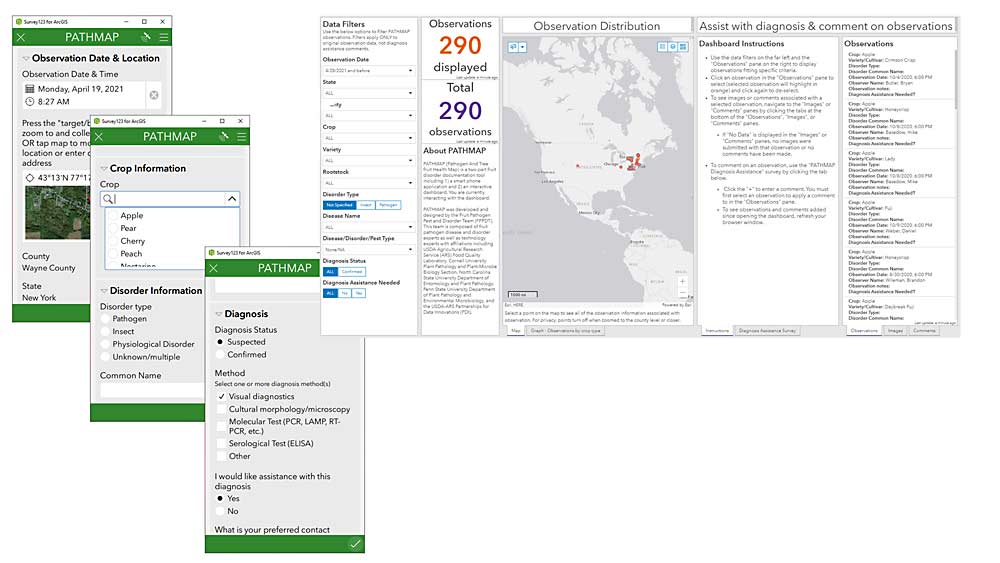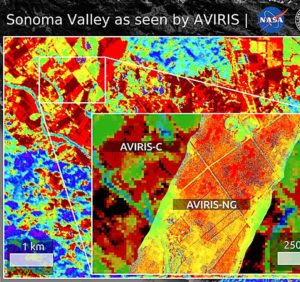
When looking for help to diagnose a plant disease, identify a pest or solve any of the myriad puzzles they’re faced with on a daily basis, researchers who study fruit pests, pathogens and disorders in the field often seek input from their colleagues. But until now, there’s never been a simple way to document those exchanges and preserve that collected knowledge.
Using the Great Lakes Fruit Workers listserv, for example, an extension educator can email a pic of a blotchy leaf, ask: “Is this fire blight?” and receive responses from fellow educators, crop consultants and the like. But as helpful as that exchange might be in the moment, in the long run it ends up at the bottom of an old email chain and can be difficult to find the next time there’s a questionable leaf blotch.
With help from a new tool called PATHMAP (Pathogen And Tree fruit Health Map), those exchanges between experts can now be archived and easily retrieved to help extension professionals help growers.
Launched in April, PATHMAP is a two-part platform, consisting of a smartphone application and an online interactive dashboard. The app user collects data on fruit crop pathogens, insect pests and physiological or other disorders. If she needs help diagnosing the disorder, she can flag the observation in the app. Other users can see the observation and provide input through the dashboard. The exchange is stored in a central database that users can later search through, said Lindsey Messinger, the tool’s technical designer and a geographic information systems analyst with Partnerships for Data Innovations, an affiliation of Colorado State University and the U.S. Department of Agriculture’s Agricultural Research Service (ARS).
Wayne Jurick, ARS lead scientist and research plant pathologist in Beltsville, Maryland, came up with the PATHMAP idea several months ago. With input from Michigan State University apple production specialist Anna Wallis and other members of the Fruit Pathogen Pest and Disorder Team, comprised of 13 scientists from around the country, Jurick gave Messinger the information she needed to design PATHMAP.
With the PATHMAP tool, Jurick wanted “more continuity in data sharing,” something that could bring multiple observations together in one place, he said. Using PATHMAP, researchers can map and visualize trends in fruit pathogen occurrence over time, and they can link those trends with rainfall, leaf wetness and degree day data. They can then use that pooled knowledge to develop models that predict future pathogen emergence, he said.
Growers can use PATHMAP, too, but the tool is aimed primarily at extension specialists and other industry support personnel who routinely visit farms to diagnose and track fruit diseases, insect pests and other disorders, Wallis said.
Kerik Cox, professor and plant pathologist at Cornell AgriTech and one of the project’s early planners, said PATHMAP can track antimicrobial resistance in the fire blight pathogen and emerging pests and diseases, but an early challenge was gathering regional information on emerging outbreaks while at the same time protecting grower privacy and financial livelihood. Fortunately, the design team came up with creative solutions to protect grower privacy while still allowing PATHMAP users to have access to specific location data, he said.
PATHMAP is primarily focused on tree fruit crops and berries, but plans are in motion to expand to other crops, including citrus and sugar beets, Jurick said.
To learn how to download and use PATHMAP, visit arcg.is/1OyjGj. •
—by Matt Milkovich







Leave A Comment